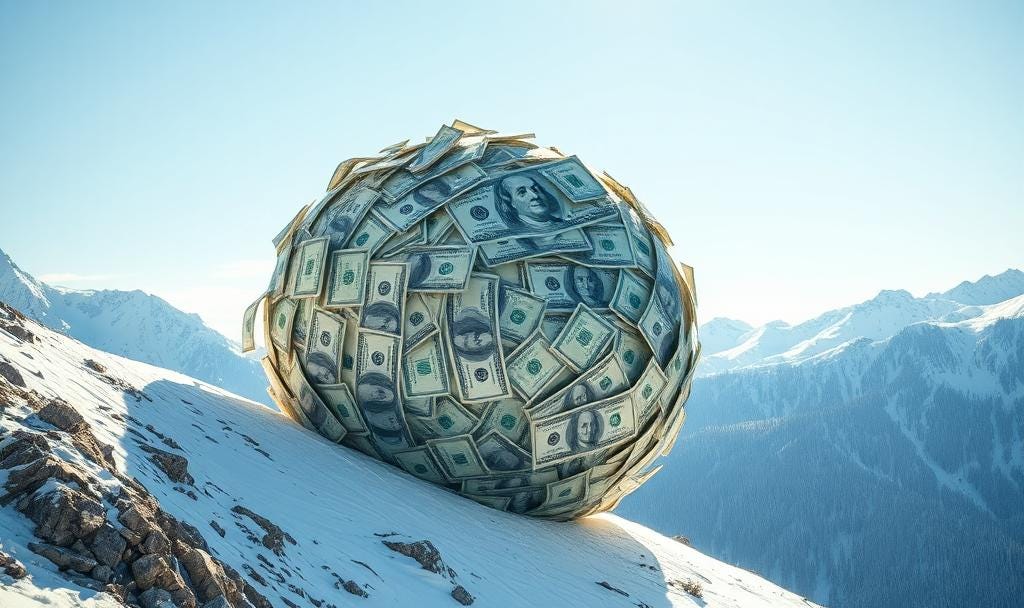Don't Compound Your Problems
Why Compounding is the Secret of Exponential Growth.
📌 The Quick Hit
• Compounding works like gravity - slow to notice, impossible to stop (if you let it run).
• The first $100,000 is where the snowball gets big enough to roll on its own.
• Interrupting compounding (by pulling money out or earning too little) kills momentum.
• The secret? Build habits that protect compounding like it’s sacred.
📖 The Background: Munger’s “First $100,000” Principle
While Charlie Munger never published a formal “formula,” he famously talked about the psychological and mathematical power of the first $100,000 in wealth building. His insight wasn’t about a mathematical threshold, but about the behavioral turning point - when compounding starts working for you in a visible, self-sustaining way.
“The first $100,000 is a b****, but you’ve got to do it. I don’t care what you have to do - if it means walking everywhere and not eating anything that wasn’t purchased with a coupon, find a way to get your hands on $100,000. After that, you can ease off a little.”
Charlie Munger
That line is classic Munger — part math, part tough love.
💵 Why $100,000 Matters
1. Psychologically:
It’s the first time the effects of compounding feel tangible.
When you start, your gains are tiny - $100 growing to $110 isn’t thrilling.
But when you have $100,000, a 10% gain* becomes $10,000 - that you can feel.
2. Mathematically:
Compounding is exponential, but you don’t see the curve early on. The $100K mark is often where the slope starts to steepen.
At that point, the returns themselves begin to produce meaningful returns - your money is working harder than you are.
3. Behaviorally:
The discipline, saving habits, and investing mindset you build to reach the first $100K are what allow compounding to keep working thereafter - automatically, quietly, and powerfully.
*Note: The S&P 500 has delivered a compounded annual growth rate of 10% since 1957. (Source: Business Insider)
👉 Buffett’s Reinforcement
Warren Buffett often echoed this sentiment:
“The snowball just happens if you start early and live long enough.”
“Life is like a snowball. The important thing is finding wet snow and a really long hill.”
The $100K milestone is when your “snowball” finally becomes large enough to roll meaningfully on its own - each rotation gathers much more “snow.”
🧗The Grind Before the Glory
Charlie Munger wasn’t being dramatic when he said the first $100,000 is hard. He meant it’s the stage where you’re building the machine, not yet benefitting from it.
It’s that period when you save aggressively, cut spending, and invest in something boring and it feels like nothing’s happening.
Because at first, nothing is.
You’re planting a tree and staring at the dirt, wondering if it’s even alive.
But once that tree takes root - once your investments reach six figures - the compounding starts to hum. At a 10% return, $100K quietly earns $10K in a year. You don’t have to lift a finger. Suddenly, money is working for you, not the other way around.
♾️ Why It Turns Exponential
Here’s the math magic (and it really is magic):
• $10,000 at 10% = $11,000 → $1,000 gain.
• $100,000 at 10% = $110,000 → $10,000 gain.
• $1,000,000 at 10% = $1,100,000 → $100,000 gain.
The rate of return hasn’t changed - but the results explode, because the compounding base has grown large enough to matter.
That’s why Munger said to get that first $100K “any way you can.” It’s not a finish line; it’s the starting line of exponential growth.
🌩️ The Dark Side: Reverse Compounding
If compounding is a miracle in forward motion, it’s a monster in reverse.
1. Earning Too Little
A 1% savings account in a 3% inflation world doesn’t just grow slowly, it shrinks quietly. Every year your purchasing power erodes. Compounding doesn’t care about your effort; it obeys the math.
• $100,000 growing at 1% becomes $101,000 after a year.
• But if prices rise 3%, your real value is $98,000.
That’s reverse compounding - a steady, polite pickpocket.
2. Pulling Money Out Too Early
The other silent killer is interruption. Every time you “tap” your investments, you stop the machine and reset the snowball.
Take out $10,000 here, $5,000 there - that’s $15,000 no longer earning returns for the next 20 years.
At 8% annual growth, that’s roughly $70,000 gone from your future.
Charlie Munger once said:
“The first rule of compounding: Never interrupt it unnecessarily.”
He meant that literally, because compounding doesn’t forgive impatience.
🔑 So What’s the Play?
Build the first $100K like your life depends on it. Because financially, it kind of does.
Invest in things that actually compound. Stocks, index funds, productive assets - not ultra-safe stagnation.
Stay out of your own way. Don’t cash out for short-term thrills or “timing the market.”
Share the good news! If you have kids, teach them about compounding. If you know people who need to hear this, share this post! 🙏
Once you hit $100K, your job shifts from building capital to protecting momentum.
That’s the quiet moment where compounding goes from theory to force of nature.
✨ Closing Thought
Compounding doesn’t shout. It whispers. (Explaining why many don’t notice it.)
It rewards the boring, the consistent, the patient.
And it punishes the impulsive with equal precision.
In the end, the math always wins → the only question is whether it’s compounding for you or against you.
🚀 Up Next:
Sunday - “Time is Money! (Or So We Thought)”
Thursday - “Your Gut is Clueless!”
This publication is for brains, not bets. The Other Side of Obvious shares ideas, stories, and general financial information—not personalized investment, tax, or legal advice. Investing comes with risk (including losing money). Talk to a pro before you act. Please take time to read these important disclosures before you get started.




Wish someone had told me this sooner before I withdrew my profits instead of "compounding", have to start from scratch! thank you for sharing such great insight. I hope those reading your articles will learn from your wisdom and not make the mistakes I made!
Thank you for this lesson.
Interesting how one can often multiply one’s own weight without realizing it. I’m curious, what’s the first small thing you suggest someone subtract when they notice they’re compounding?